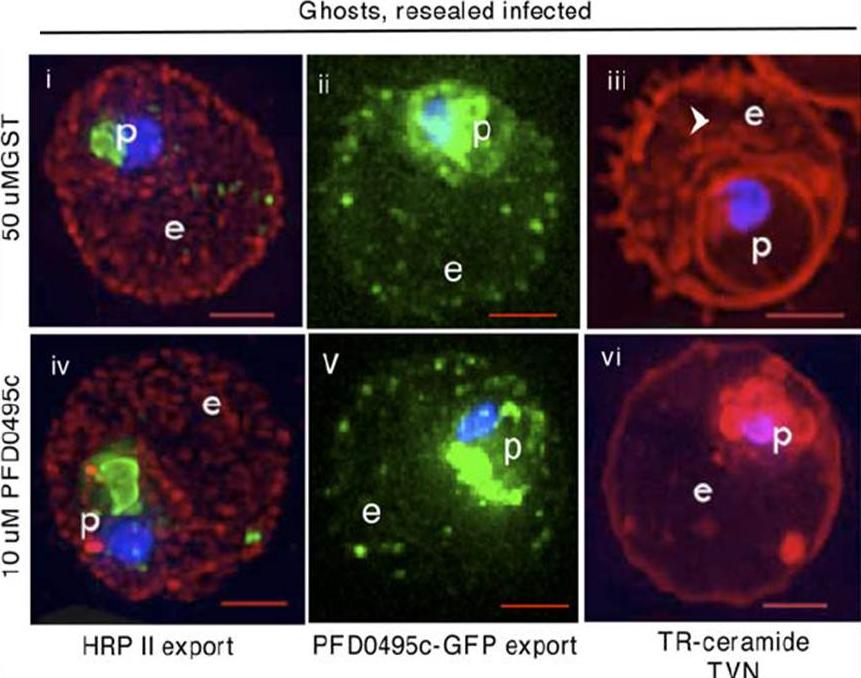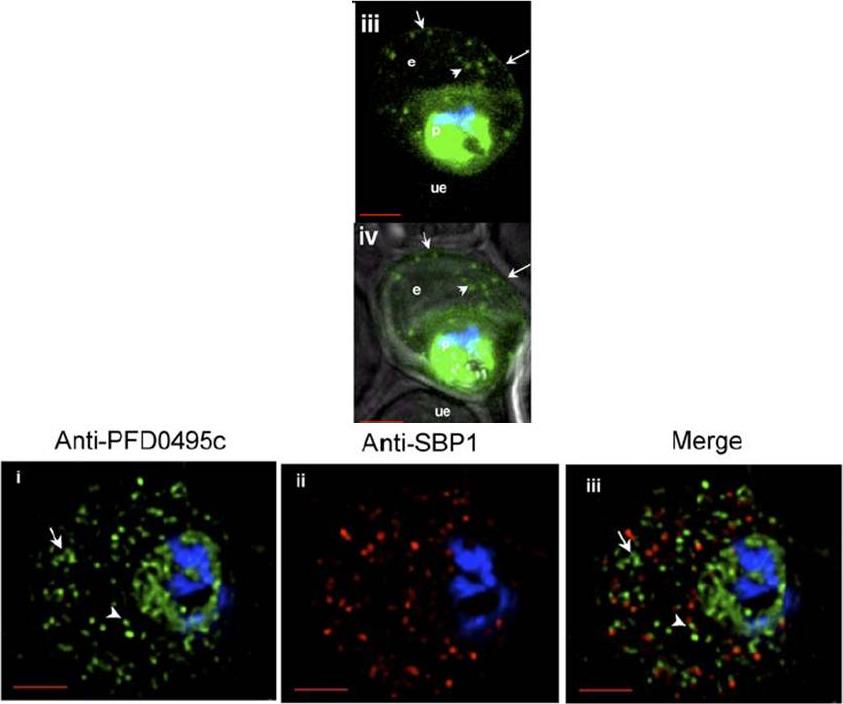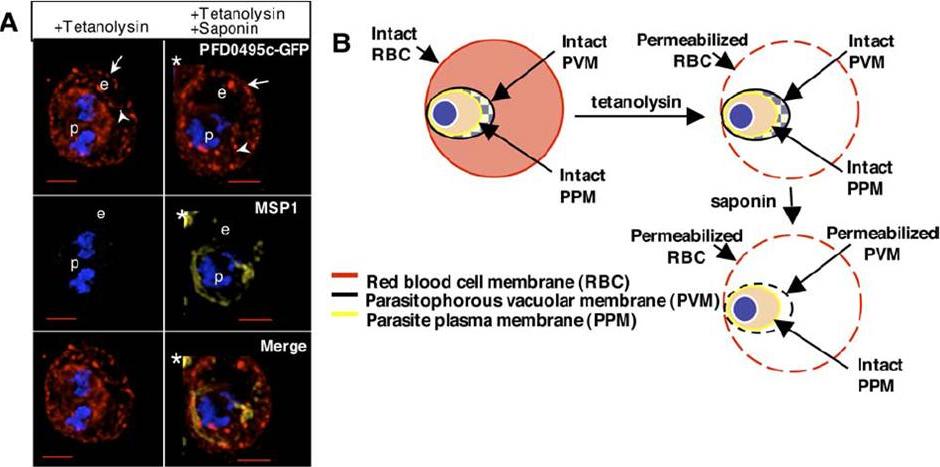PVP01_0309300 erythrocyte vesicle protein 1, putative (EVP1)
Disruptability [+]
| Species | Disruptability | Reference | Submitter | |
|---|---|---|---|---|
| P. berghei ANKA |
Possible |
PlasmoGEM (Barseq) | PlasmoGEM | |
| P. falciparum 3D7 |
Possible |
18614010 | Theo Sanderson, Wellcome Trust Sanger Institute | |
| P. falciparum 3D7 |
Possible |
USF piggyBac screen (Insert. mut.) | USF PiggyBac Screen | |
Mutant phenotypes [+]
None reported yet. Please press the '+' button above to add one.Imaging data (from Malaria Metabolic Pathways)

PFD0495c regulates the TVN in the infected erythrocyte cytoplasm. (A) Early schizonts (3D7 i and clone 1 parasites expressing PFD0495c-GFP ii) were stained with TR-ceramide (red; to visualize the TVN) and Hoechst 33342 (blue; to visualize DNA) and imaged live. Transgenic parasites display large TVN loops (arrows, panel ii) rather than tubules prominent in 3D7 (arrows, panel i). (B) Transgenic P. falciparum parasites expressing pfhrpii-gfp (i–ii) or pfd0495c-gfp (iii–iv) treated in absence (i, iii) or presence (ii, iv) of 5 mM PPMP for 30 min were incubated with membrane impermeable endocytic lipid marker FM4-64 (red) also for 30 min and imaged live. A second copy of pfd0495c promotes internalization of FM4-64 probe in the presence of PPMP (iv versus ii). (C) Ring stage parasites (3D7 i, pfd0495c-gfp clone 1 ii) were incubated with 5 mM PPMP for 24 hr, stained with TR-ceramide (red) and Hoechst (blue) and imaged live. Clone 1 accumulates an abundance of small loops and tubovesicular structures compared to few punctate spots in 3D7. Clone 1 parasites also show two nuclei (blue) and an almost two fold increase in size compared to 3D7 (that contain only one nucleus). Arrows show tubules, loops; arrowheads, vesicular structures; small arrowheads, punctate spots. For all panels erythrocyte (e), parasite (p) and intraerythrocytic structures (arrow). Scale bar, 2 mm.Tamez PA, Bhattacharjee S, van Ooij C, Hiller NL, Llinás M, Balu B, Adams JH, Haldar K. An erythrocyte vesicle protein exported by the malaria parasite promotes tubovesicular lipid import from the host cell surface. PLoS Pathog. 2008 Aug 8;4(8):e1000118. PMID:
See original on MMP
PFD0495c is important for proper development of the TVN. Trophozoite stage parasites in ghosts resealed with 50 mM GST (i, ii, iii), or 10 mM GST. PFD0495cCterm (Biv, v, vi), were infected with: (i, iv) 3D7 P. falciparum and probed with anti-HRPII (red), anti-MSP1 (green, to mark the parasite) and Hoechst 33342 (blue to stain parasite DNA); (ii, v) clone 1 expressing PFD0495c-GFP and visualized live for green fluorescence; (iii, vi) 3D7 P. falciparum stained with the membrane permeable probe TR-ceramide and visualized live.Tamez PA, Bhattacharjee S, van Ooij C, Hiller NL, Llinás M, Balu B, Adams JH, Haldar K. An erythrocyte vesicle protein exported by the malaria parasite promotes tubovesicular lipid import from the host cell surface. PLoS Pathog. 2008 Aug 8;4(8):e1000118.
See original on MMP
Upper panel: PFD0495c is exported to the erythrocyte. (iii) fluorescence image of pfd0495c-gfp expressing parasites. Fluorescence image of pfd0495c-gfp expressing parasites (iv) fluorescence and DIC image showing export ofPDF0495c chimera to the erythrocyte (e) periphery (arrow) andintraerythrocytic spots (arrowhead).Lower panel: PFD0495c is found within intraerythrocytic structures. 3D7 early schizonts were fixed and probed with antibodies to PFD0495c (i) and Skeleton Binding Protein (SBP1; ii) for immunofluorescence. Endogenous PFD0495c is found associated with the parasite and within intraerythrocytic structures, vesicular (arrowhead) and tubular (arrow) structures, distinct from Maurer’s Clefts (iii).Tamez PA, Bhattacharjee S, van Ooij C, Hiller NL, Llinás M, Balu B, Adams JH, Haldar K. An erythrocyte vesicle protein exported by the malaria parasite promotes tubovesicular lipid import from the host cell surface. PLoS Pathog. 2008 Aug 8;4(8):e1000118.
See original on MMP
The C-terminus of PFD0495c functions within the erythrocyte cytoplasm and mediates interactions important forintraerythrocytic development. (A) Topology of PFD0495c in transgenic clone 1 parasites. C-terminus of PFD0495c-GFP is localized to erythrocyte cytoplasmic face. Anti-GFP signal is detected after tetanolysin permeabilization. Control signal to PPM (aMSP-1) is detected only with saponin treatment. p, parasite; e, erythrocyte; arrow, erythrocyte membrane; arrowhead, intraerythrocytic vesicle/tubule. Asterisk marks neighboring cell. (B) Schematic of selective permeabilization experiment. Tetanolysin selectively permeabilizes only the erythrocyte plasma membrane, leaving the PVM intact. Only incombination with saponin will the PVM be permeabilized and control MSP1 antibodies gain access to epitope. If anti-GFP signal can be detected with tetanolysin alone, then the C-terminus is present on the cytoplasmic face of the erythrocyte.Tamez PA, Bhattacharjee S, van Ooij C, Hiller NL, Llinás M, Balu B, Adams JH, Haldar K. An erythrocyte vesicle protein exported by the malaria parasite promotes tubovesicular lipid import from the host cell surface. PLoS Pathog. 2008 Aug 8;4(8):e1000118.
See original on MMPMore information
| PlasmoDB | PVP01_0309300 |
| GeneDB | PVP01_0309300 |
| Malaria Metabolic Pathways | Localisation images Pathways mapped to |
| Previous ID(s) | null |
| Orthologs | PBANKA_1007600 , PCHAS_1008500 , PF3D7_0410000 , PKNH_0308100 , PVX_000745 , PY17X_1009000 |
| Google Scholar | Search for all mentions of this gene |